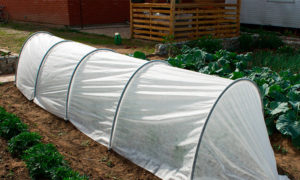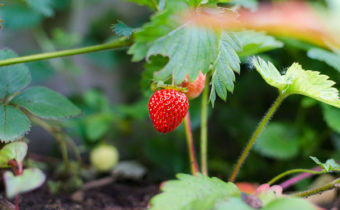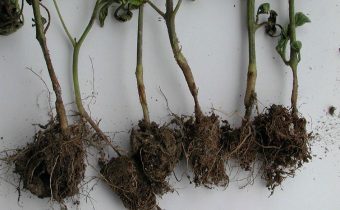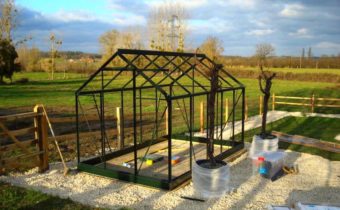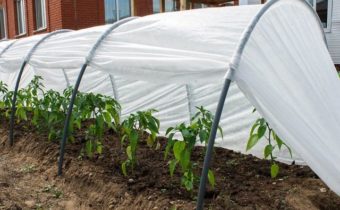How to choose a film for greenhouses and greenhouses?
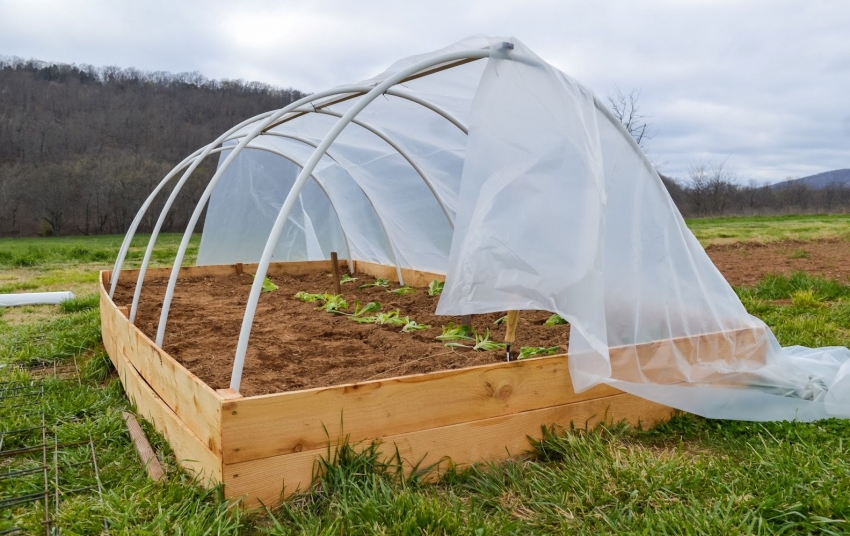
Polyethylene film for a long time remained the most budget material of covering type. However, then its popularity fell due to the short service life, low strength, low insulating ability.
Manufacturers have proposed films for completely different types of greenhouses with good light permeability, insulating indicators that can withstand significant tension and tear loads. Of all the new materials, you can choose the best both in price and quality.
Hydrophilic material with stabilization
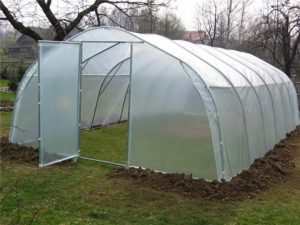
Gardeners and gardeners have to change polyethylene shelters due to such a phenomenon as the decomposition of the polymer under the influence of ultraviolet radiation. Fibers gradually lose their elasticity, become thinner, as a result, the film completely loses its properties. Hydrophilic material is a modified version, in which elements have already been added that make the fibers immune to the ravages of sunlight.
Ultraviolet destroys covering materials even in the most cloudy regions. A small number of sunny days does not indicate a low level of radiation.
In terms of installation and disposal of such films are no different from all the others. They are easy to break through with sharp objects, so the installation is carried out carefully, using to create greenhouses: plastic pipesclamps and frame. Lifetime can be determined by the color of the material yellow - up to a year, red - up to two years, green - up to three years.
Reinforced canvas
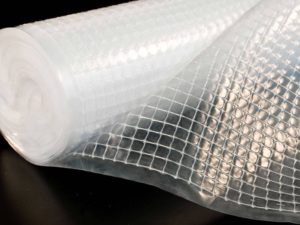
In the production of reinforced covering materials, light-stabilized polyethylene is taken as a basis, additionally reinforcing it with propylene filaments. It is possible to obtain material that is good for covering large areas with a minimal frame.
The film of this type is not widespread due to controversial properties. On the one hand, it is indispensable for wind loads. High and long greenhouses with a light frame are the main field of application, especially in regions of high-risk agriculture. But from the mechanical impact, the reinforced material is also easily torn, it requires careful fastening with special clamps. At the same time, the coefficient of light permeability due to the addition of polypropylene gives at least 20 percent. The period of decomposition in the natural environment also increases significantly, so it cannot simply be thrown out; it is imperative that it be returned for recycling.
It is easy to break through such a film with a sharp object, so it still requires accuracy in installation and further maintenance.
When choosing a multi-year reinforced film, you need to pay special attention to the density of propylene filaments. The higher it is, the stronger the canvas, the less light and air it passes. You can find products with special vents, but they are much more expensive. In some cases, the reinforcement is carried out using glass fibers. Such materials will be unsuitable for use in agriculture if they are performed in violation of standards. Fibers can contaminate the soil and water if they break through to the surface, therefore a compound with polypropylene is considered safe.
Unstabilized species
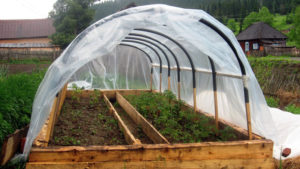
Polyethylene ordinary film, which did not undergo stabilization, was the first to come into use in private households. This is the thinnest canvas with minimal strength and durability. It is used as a shelter for one season, and it is better to use it for greenhouses and greenhouses, which are planted from mid-spring to mid-autumn. The material transmits up to 90 percent of radiation, so the plants will receive a maximum of ultraviolet radiation, but also cool the air inside quickly enough.
During spring frosts, it is important not to keep the temperature inside, and not to let the cold mist settle on the plants and the soil, so even a thin film is effective.
The service life of such canvases is one season. They are most often sold in pure form, that is, as a part of only low and high pressure polyethylene, without copolymer additives. If the composite has more LDPE, the stretch effect will be clearly pronounced, but the service life and strength are even lower. The more in the composition of the HDPE, the thicker the canvas, the more resistant it is to mechanical stress, but less elastic. In unstabilized form is offered and a film of PVC. Its use and even manufacturing is prohibited in many EU countries due to the high level of toxicity of the material itself. Polyethylene products are absolutely safe, so it is recommended to buy them.
When installing, be careful and follow the tips:
- It is impossible to allow excessive stretching, it is permissible to lay the canvas in two layers to increase strength and heat insulation.
- As a frame, it is better to use smooth pipes PP of small diameter.
- Many site owners burn such a film after one season, it is permissible if the area of the canvas is small, but it would be more correct to hand it over to processing centers.
- When buying you need to pay attention to the class of environmental friendliness. Manufacturers can use those substances that are considered relatively safe. For example, additives for transparency are toxic when burned or strongly heated.
Air Bubble Materials
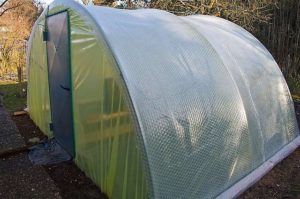
Bubble film, widely used in packaging, can be a reliable protection for plants from cold and wind. This material is made from high-pressure polyethylene, so it is not elastic, but strong and durable. Unlike thinner films, the air-bubble type is not afraid of mechanical damage, it does not disperse after a breakthrough and can be quickly restored. Each bubble is a separate chamber with air, so when damaged, the entire canvas retains its properties.
The smaller the camera, the more convenient to use the canvas for covering.
Bubble covering materials are excellent for mounting on metal and wooden frames, to cover large areas. They do a good job with wind and even snow load, because they have a high strength indicator. The bubbles do not focus the light, so the plants do not get burned. But this shape of the surface leads to the fact that condensate rolling is difficult, so it may run off on the leaves, which is unacceptable for some greenhouse crops.
It is possible to fix such material with the help of special plugs and snaps, and with the help of ordinary beadings. Stretch it can not, on the contrary, it is recommended to leave a little free in order to increase resistance to wind. Store film with bubbles should be in a roll. It is not toxic to the environment, but does not decompose, so it can not be thrown out.
Bubble film production is a costly process, some manufacturers save on changing the ratio of additives to the base material, and include secondary raw materials in the mixture of polymers.Such films should cost much less, so when you buy, you should carefully examine the composition. Covering sheets based on recycled products are much worse to transmit light.
Heat-retaining polyethylene
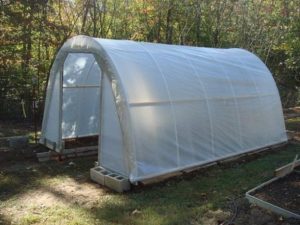
A number of materials have similar properties. First of all, these are already named air-bubble canvases. In them, the temperature is maintained due to the presence of insulated chambers and a large thickness of covering material. Another design is opaque polyethylene films that have special heat generation properties due to the conversion of ultraviolet rays. Manufacturers achieve this effect by creating complex polymers with many additives. The basis is the same - polyethylene in various combinations; film gives opacity to polypropylene, which has a minimum capacity in terms of heat.
Advantages and disadvantages:
- Such covering materials have a very small service life at a high price. This is the main disadvantage.
- More than one season they are not used, if the greenhouse is year-round, replacement may be required after 7 or 8 months.
- By its strength - it is almost a reinforcing film for large greenhouses, breaking a thick layer of material is quite difficult. Therefore, installation is not difficult.
- When installing a greenhouse, you need to choose the most sunny place so warming up will be the best, and the illumination is optimal. In such greenhouses, the crop ripens about 15-20 percent faster, so they are often used for industrial purposes.
From the point of view of environmental friendliness, such durable films for greenhouses are not the most dangerous. They are completely harmless to the environment, decompose faster than many of their counterparts, especially in the presence of sunlight. But it is impossible to burn material because of a large number of additives, as well as to bury it in the ground.
Polyethylene is safe from the point of view of ignition. It instantly melts, not supporting combustion, so it can be used even near the house.
Materials of this type are best suited for year-round greenhouses, in which crops are planted both in winter and in summer. However, it is necessary in the construction of the frame to provide for the possibility of opening and frequent ventilation. Since the heat does not go anywhere from the inner space, the effect of vomiting may occur, which is dangerous for plants.
These properties are directly related to frost resistance. Such films are well suited for harboring permanent greenhouses that do not clean for the winter, especially in northern climates. At temperatures up to minus 80 degrees, the film does not “dub up” and does not crack. It loses a bit of elasticity, so during such a period it is better not to perform any manipulations with it, but to wait for at least some warm-up.
Ethylene acetate
Many people call the best film for greenhouses canvases of a copolymer of ethylene and acetate. These are special types of polymers that have increased mechanical strength. They also sometimes add hydrophilic granules, the composition is frost-resistant. Due to this, such a film can last for several seasons. It is well suited for large non-separable greenhouses and even winter greenhouses. The optimum thickness of the material for covering up to 0.5 millimeters. Although the sale can be found and films up to 1 millimeter thick, but they already almost do not let the sun's rays. The main drawback of this material is the probability of overheating of plants in warm weather under intense sunlight.
The full name of this type of film is ethylene vinyl acetate. It is a cross between polyethylene and vinyl chloride. But unlike PVC, such a covering material is completely safe for both ecology and humans. The main disadvantage is low resistance to temperature effects, which does not allow using this type of material in extremely hot climates to protect plants.The film allows up to 98 percent of the ultraviolet, so the air inside will warm up in sunny weather instantly. If the frame of the greenhouse is metallic, in such conditions it will quickly warm to the temperature critical for the material. Already at plus 55 degrees, melting can begin. Therefore, when assembling a greenhouse, it is better to choose a plastic or wooden case.
All metal, including light aluminum and galvanized steel, is equally heated in the sun.
Ethylene acetate has a high elasticity, so when installing it should be gently pull. The film is not afraid of punctures, so fasteners can even be used inexpensive. The service life is about three years, but in that case, if the greenhouse is not collapsible.
When choosing a film for greenhouses or greenhouse It is worth paying attention not only to the price, but also to the service life, the insulating properties. Indicators of light stabilization are relevant for a sunny and hot climate, while for the northern regions the material's ability to withstand low temperatures and retain heat inside is important. When buying, you should carefully study the composition, safety and environmental performance, so you can find an option for any task.

